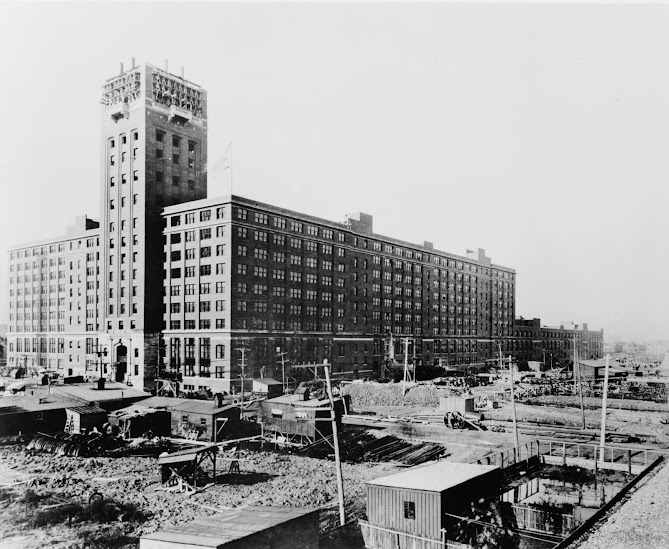The Sears Tower (now Willis Tower), 233 South Wacker Drive, Chicago, was once the tallest building in the world, 1,729 feet at the highest point, with 108 floors until 1998. It is easily one of Chicago's most recognizable buildings. However, the 'Loop' Sears Tower was not the first Sears Tower in Chicago.
In 1904, the company purchased over 40 acres of land on Chicago's West Side and embarked on one of the most significant retail development projects. The Sears Merchandise Building Tower complex occupied an area bounded on the north by Arthington Street, the south by Fillmore Street, the east by Spaulding Avenue, and the west by Central Park Avenue.
The Sears Merchandise Building Tower at 925 South Homan Avenue, Chicago, is a fourteen-story structure with a limestone base and Chicago Common Brick walls. It is crowned by a Classical Revival top floor round-arch windows and a modillion cornice. It housed water tanks for firefighting, offices, and secretarial training facilities on the upper levels. It also housed the early radio broadcast facilities for WLS-AM.
The centerpiece of the company-owned "city within a city" was its central administration building, a merchandise development house, a mail-order processing facility, and a power plant large enough to provide electricity and heat to the entire complex.
 |
| The full extent of the Sears, Roebuck, and Company Complex (towering cluster of buildings in the center) circa 1950. CLICK FOR A FULL-SIZE PICTURE |
By 1926, the first ground-level parking lots replaced the athletic fields. This happened when a strategic shift from catalog sales to retail stores started with easy auto travel, making travel to a store more practical.
By 1943, the complex had become a city within itself. Sears created their own services for practical use, which were well advanced in what was required at the time, including:
- A company fire department with volunteer firemen and early fire sprinklers.
- A 200,000-gallon water tank is also used for fire prevention purposes.
- A newspaper publicity office.
- A cafeteria serving breakfast and lunch—initially, men and women were separated.
- A private bank offering discounted services for employees on-site (today, a Credit Union).
The company's growth continued through the 20th century, and by the 1960s, it was the largest retailer in the world.
The company's growth continued through the 20th century, and by the 1960s, it was the largest retailer in the world. Changing trends in retail sales and methods led to a decline, and the company's mail-order business was scaled back in 1987, moving out of these premises. The corporate headquarters had been moved to the new Sears Tower in 1973.
The complex stood vacant for nineteen years.
The abandoned complex presented the City of Chicago with a redevelopment quagmire. In 1992, a nonprofit partnership organized by former Sears management began to redevelop the site named Homan Square. The mail-order merchandise building was demolished, except for its main tower, and its land has been redeveloped to include new residences, retail, and a community center.
In 2015, the tower was renamed the "John D. and Alexandra C. Nichols Tower, which restored the building. It is now a hub for nonprofit arts, multi-media education, youth leadership development, job training, and more. The School of the Art Institute of Chicago has its classroom on the 12th floor. The Sears Roebuck plaque is still visible on top of the building.
The surviving buildings can be seen from Homan and Arthington.
Compiled by Dr. Neil Gale, Ph.D.






